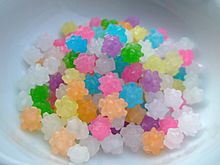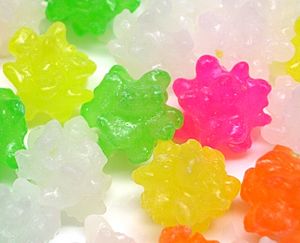Konpeitō facts for kids

Konpeitō in various colors
|
|
| Type | Confectionery |
|---|---|
| Place of origin | Portugal |
| Main ingredients | Sugar, water |
Konpeitō (金平糖, こんぺいとう), also spelled kompeitō, is a special type of Japanese sugar candy. It looks like a tiny ball with a bumpy surface. You can find it in many different colors and flavors.
Contents
What's in a Name?
The name Konpeitō comes from the Portuguese word confeito. This word means a type of sugar candy, similar to what we call a comfit.
The Japanese characters for Konpeitō (金平糖) mean "golden flat sugar." These characters were chosen mostly because they sound like the Portuguese word.
A Sweet History
The way to make sugar candy came to Japan in the early 1500s. It was brought by Portuguese traders. At that time, Japan didn't have much sugar. So, Konpeitō was very rare and expensive.
In 1569, a Portuguese missionary named Luís Fróis gave a glass bottle of Konpeitō to Oda Nobunaga. Nobunaga was a powerful leader in Japan. This gift helped the missionary get permission to teach about Christianity.
By the Meiji period (1868-1912), Konpeitō was a well-known Japanese sweet. It even inspired the "Sugar Plum Fairy" in the famous ballet The Nutcracker. In Japanese, she is called the "Fairy of Konpeitō."
How Konpeitō is Made
Konpeitō candies are usually about 5 to 10 millimeters (about 0.2 to 0.4 inches) wide. They are made by slowly adding sugar syrup over a tiny core. This core is often a grain of coarse sugar. Long ago, poppy seeds were used as the core.
The process is a bit like making a dragée. The candies are rotated slowly in a big, heated, gong-shaped tub called a dora. More sugar syrup is added as they turn. This makes each tiny sugar grain grow bigger. It also forms the many small bumps on the surface.
It takes a long time to make Konpeitō, usually between 7 to 13 days. Even today, skilled artisans still make these candies by hand.
Other Ways Konpeitō is Used
The Japanese Ministry of Defense includes Konpeitō in its emergency food rations. These are given to soldiers and in disaster kits. The candies provide energy and help people make saliva. This makes it easier to eat dry foods like hard tack biscuits.
The Ministry of Defense also thinks that colorful Konpeitō can help reduce stress during tough times.
Konpeitō is often given as a gift for happy events. These include weddings and the birth of a baby. The candies come in fancy boxes called bonbonniere. This word comes from the French word for "candy box." Giving these boxes has been a symbol of good luck since 1889. The Japanese Imperial Family has used Konpeitō as an official welcome gift for over 130 years!
Konpeitō in Pop Culture
You might have seen candies like Konpeitō in video games and movies!
- In Super Mario Galaxy and its sequel, the "Star Bits" look like Konpeitō.
- The "Gratitude Crystals" and "Star Fragments" in The Legend of Zelda games are also similar.
- "Star Fragments" in Animal Crossing and some items in the Pokémon series (like Minior and Cosmog's star candies) are inspired by them.
- The little dust creatures called susuwatari in Studio Ghibli films like Spirited Away are shown eating Konpeitō.
- In Super Mario RPG, "Rock Candy" is an attack item that looks like Konpeitō.
- The children's anime Hamtaro also featured these candies. They were called "diamonds of sugar" in the English version.
See also
 In Spanish: Kompeitō para niños
In Spanish: Kompeitō para niños


